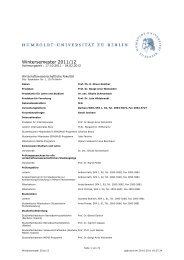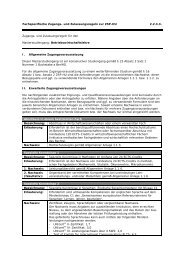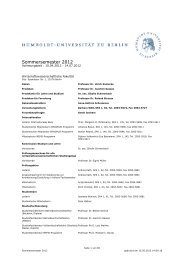Measuring the Effects of a Shock to Monetary Policy - Humboldt ...
Measuring the Effects of a Shock to Monetary Policy - Humboldt ...
Measuring the Effects of a Shock to Monetary Policy - Humboldt ...
You also want an ePaper? Increase the reach of your titles
YUMPU automatically turns print PDFs into web optimized ePapers that Google loves.
Bayesian FAVARs with Agnostic Identification 9<br />
estimates <strong>of</strong> <strong>the</strong> impact <strong>of</strong> monetary policy shocks and changes in policy on various sec<strong>to</strong>rs<br />
<strong>of</strong> <strong>the</strong> economy, if <strong>the</strong>re exists no reasonable objective means <strong>of</strong> determining <strong>the</strong> direction<br />
and size <strong>of</strong> changes in policy stances 6 .<br />
<strong>Monetary</strong> policy decisions are implicitly assumed <strong>to</strong> take place in a ”data-rich envi-<br />
ronment” 7 , reflecting that <strong>the</strong> central bankers analyze a vast amount <strong>of</strong> economic time<br />
series 8 prior <strong>to</strong> <strong>the</strong>ir policy decisions taken. The fact that central bankers bear this huge<br />
cost <strong>to</strong> analyze such a plethora <strong>of</strong> data and assuming that <strong>the</strong>y do not have a great<br />
irrational interest in wasting <strong>the</strong>ir time with dispensable data analysis, should provide<br />
<strong>the</strong> indication that a broad set <strong>of</strong> ”information” is <strong>of</strong> great relevance for <strong>the</strong> decisions<br />
<strong>to</strong> be taken. Hence much more variables would have <strong>to</strong> be considered for example if a<br />
researcher would be interested <strong>to</strong> model <strong>the</strong> monetary transmission mechanism, or <strong>the</strong><br />
Fed’s reaction function. The limitation does not come from <strong>the</strong> modeling researchers ig-<br />
noring <strong>the</strong> importance <strong>of</strong> <strong>the</strong> large data set, but from <strong>the</strong> methodologies mainly applied.<br />
The advantage <strong>of</strong> <strong>the</strong> SVAR framework is that it is small and <strong>the</strong>refore more tractable<br />
and easier <strong>to</strong> compute. Bernanke and Boivin (2003) were <strong>the</strong> first who tried <strong>to</strong> tackle <strong>the</strong><br />
problem <strong>of</strong> ”information dimensions” in <strong>the</strong> context <strong>of</strong> monetary policy in a framework<br />
that combines <strong>the</strong> advances <strong>of</strong> dynamic fac<strong>to</strong>r models with standard VAR analysis. They<br />
”explore <strong>the</strong> feasibility <strong>to</strong> incorporate a richer information set in<strong>to</strong> <strong>the</strong> analysis <strong>of</strong> positive<br />
and normative Fed policy making” 9 . They achieve this through a fac<strong>to</strong>r model approach<br />
based on <strong>the</strong> work <strong>of</strong> S<strong>to</strong>ck and Watson (1999,2002) and Watson (2000). Dynamic fac<strong>to</strong>r<br />
models that were introduced <strong>to</strong> economics by <strong>the</strong> seminal papers <strong>of</strong> Geweke (1977) and<br />
Sargent and Sims (1977), put <strong>the</strong> classical fac<strong>to</strong>r model, that only regards cross-sectional<br />
data, in a dynamic setting. These models have become increasingly popular since <strong>the</strong> work<br />
by S<strong>to</strong>ck and Watson (1989,1999,2003) that outperformed <strong>the</strong> forecasting accuracy <strong>of</strong> <strong>the</strong><br />
6 See Bernanke and Mihov (1998a)<br />
7 see Bernanke and Boivin (2003)<br />
8 Bernanke and Boivin (2003), state that central bankers literally moni<strong>to</strong>r several hundreds or even up<br />
<strong>to</strong> thousand time series.<br />
9 See Bernanke, Boivin [2003]


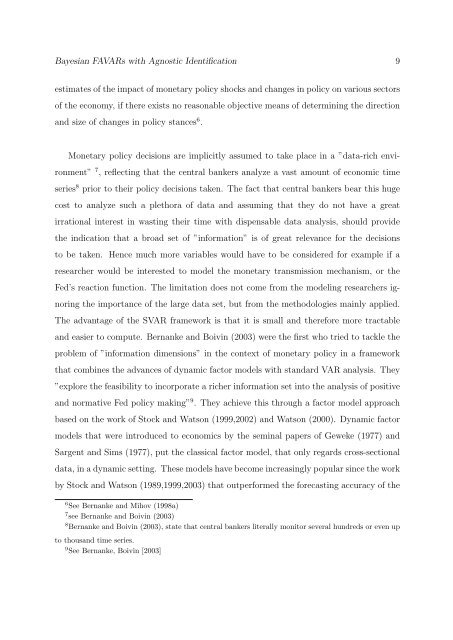
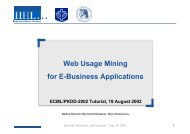
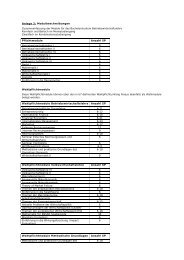


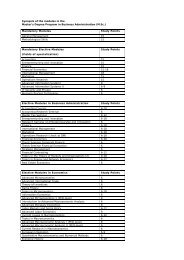

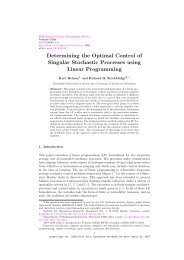



![[Text eingeben] [Text eingeben] Lebenslauf Anna-Maria Schneider](https://img.yumpu.com/16300391/1/184x260/text-eingeben-text-eingeben-lebenslauf-anna-maria-schneider.jpg?quality=85)

